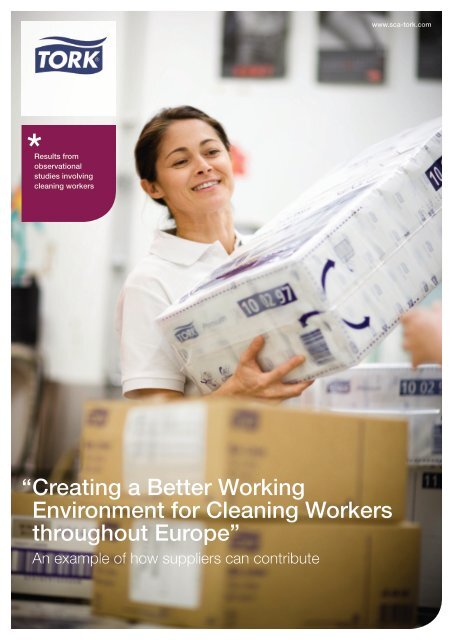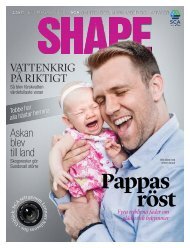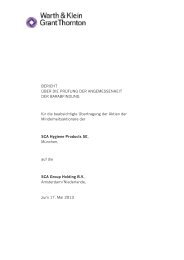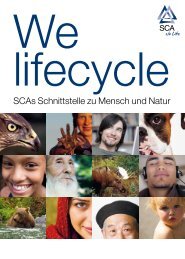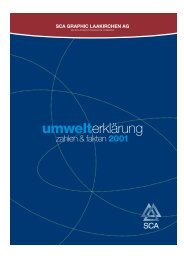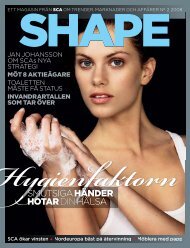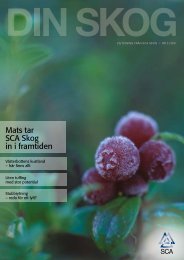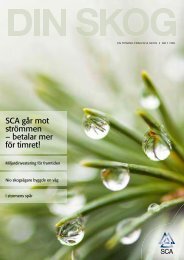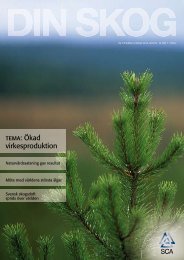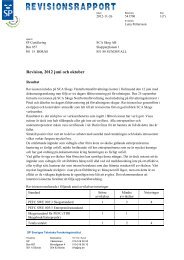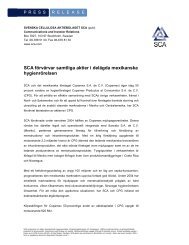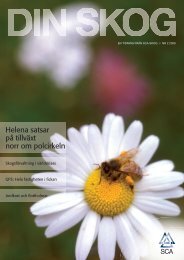the study and Tork Easy Handling here - SCA
the study and Tork Easy Handling here - SCA
the study and Tork Easy Handling here - SCA
Create successful ePaper yourself
Turn your PDF publications into a flip-book with our unique Google optimized e-Paper software.
Results from<br />
observational<br />
studies involving<br />
cleaning workers<br />
“ Creating a Better Working<br />
Environment for Cleaning Workers<br />
throughout Europe”<br />
An example of how suppliers can contribute<br />
www.sca-tork.com
A Message from <strong>the</strong> President of AFH<br />
Professional Hygiene Europe<br />
We just take some things for granted. We get <strong>the</strong> newspaper in <strong>the</strong> morning, <strong>the</strong><br />
bus arrives on time, <strong>and</strong> our workplace is clean when we arrive in <strong>the</strong> morning.<br />
These things don’t happen by <strong>the</strong>mselves – <strong>the</strong>re are people behind each <strong>and</strong><br />
every one of <strong>the</strong>m: <strong>the</strong> mechanic who fixes <strong>the</strong> bus, <strong>the</strong> newspaper delivery person,<br />
<strong>and</strong> <strong>the</strong> cleaning worker who cleans <strong>the</strong> office at night. These are <strong>the</strong> individuals<br />
who make our society work; without <strong>the</strong>m, <strong>the</strong> things we take for granted would<br />
stop working.<br />
The European cleaning industry is a flourishing industry. The number of companies<br />
is five times higher today than it was 20 years ago <strong>and</strong> <strong>the</strong> number of employees<br />
has increased by five percent each year in <strong>the</strong> last decade. Today, some four million<br />
cleaners help keep our society clean <strong>and</strong> healthy. <strong>Tork</strong> is proud to be a leading supplier<br />
of away-from-home paper <strong>and</strong> hygiene products <strong>and</strong> services to this industry.<br />
However, <strong>the</strong> industry also faces some challenges. Cleaning workers are working<br />
in tough environments <strong>and</strong> <strong>the</strong> rate of sick leave <strong>and</strong> work-related health problems<br />
is higher in <strong>the</strong> cleaning industry than in many o<strong>the</strong>r sectors. This is a problem not<br />
only for <strong>the</strong> affected individuals, but for <strong>the</strong> industry as a whole.<br />
<strong>SCA</strong> with its professional hygiene paper br<strong>and</strong> <strong>Tork</strong> wants to add value for all<br />
stake holders. Through responsible operations, caring for people <strong>and</strong> nature, <strong>and</strong> our<br />
sustainable solutions, we play an essential role in improving <strong>the</strong> quality of everyday<br />
life. We are aware of <strong>the</strong> cleaning workers’ situation <strong>and</strong>, as a major supplier to <strong>the</strong><br />
industry, we know that we have a responsibility to do everything we can to improve<br />
<strong>the</strong> working environment. We have produced this report in order to show how we<br />
have started to incorporate a caring dimension when we develop products.<br />
We want our products to make life easier for <strong>the</strong> people who work with <strong>the</strong>m.<br />
We realize that developing our products is not <strong>the</strong> complete solution to <strong>the</strong> challenges<br />
that <strong>the</strong> cleaning industry is facing. However, we believe that it is an important first<br />
step that can inspire o<strong>the</strong>r actors to do <strong>the</strong>ir share. If everyone in <strong>the</strong> cleaning industry<br />
– distributors, producers, or cleaning companies, among o<strong>the</strong>rs – do what <strong>the</strong>y can,<br />
we believe that we toge<strong>the</strong>r can improve <strong>the</strong> situation for <strong>the</strong> cleaning workers.<br />
This will benefit everyone. This will ensure that <strong>the</strong> things we all take for granted<br />
continue to work. As Europe’s No. 1 hygiene paper br<strong>and</strong> for professionals, we<br />
want to inspire <strong>and</strong> lead <strong>the</strong> way. Through creative <strong>and</strong> innovative ways of thinking<br />
<strong>and</strong> working, we aim to provide industry leadership <strong>and</strong> inspiration.<br />
Sune Lundin<br />
President of AFH Professional Hygiene Europe
The European Cleaning Industry –<br />
A Flourishing Sector<br />
Every day, some four million cleaners go to work in Europe. They help keep<br />
our workplaces, schools, <strong>and</strong> hospitals clean <strong>and</strong> ensure <strong>the</strong> well-being of<br />
<strong>the</strong> entire society.<br />
The cleaners do not only contribute to <strong>the</strong> physical wellbeing of Europe; <strong>the</strong><br />
industry also contributes greatly to <strong>the</strong> European economy, with an estimated<br />
annual turnover of approximately 60 billion Euros.<br />
The industry has also seen a strong <strong>and</strong> uninterrupted growth for more than<br />
20 years, in <strong>the</strong> number of companies <strong>and</strong> employees <strong>and</strong> turnover. Since 1989,<br />
<strong>the</strong> number of cleaning companies in Europe has increased from around 31,000<br />
to approximately 158,000 (see Figure 1). The number of cleaners has increased<br />
by an average of more than five percent annually in <strong>the</strong> last 10 years. 1<br />
1 80000<br />
1 60000<br />
1 40000<br />
1 20000<br />
1 00000<br />
80000<br />
60000<br />
40000<br />
20000<br />
Figure 1. The number of cleaning companies in Europe 1989 – 2010<br />
1 European Federation of Cleaning Industries, http://www.feni.be/index.php?id=18<br />
Number of cleaning companies<br />
0<br />
1989 1991 1993 1995 1997 1999 2001 2003 2005 2007 2009
The European Cleaning Industry –<br />
A Sector with Challenges<br />
Despite being a prosperous <strong>and</strong> flourishing sector, <strong>the</strong> cleaning industry has some<br />
substantial challenges. Cleaners work in exposed environments <strong>and</strong> since <strong>the</strong><br />
cleaning industry is a highly labor-intensive sector – approximately 75 percent of <strong>the</strong><br />
cleaning companies’ total costs are labor costs 2 – <strong>the</strong> well-being of <strong>the</strong> employees<br />
is vital to <strong>the</strong> industry. T<strong>here</strong>fore, it is troubling that <strong>the</strong> cleaners are affected by<br />
working environment problems to a greater degree than most occupations.<br />
Due to <strong>the</strong> lack of official statistics on a European level, it is hard to reach<br />
conclusions about <strong>the</strong> exact numbers of work-related health problems <strong>and</strong> sick<br />
leave in <strong>the</strong> European cleaning industry as a whole. However, it is possible to give<br />
a rough picture by looking at statistics from individual countries.<br />
In Germany, cleaners have an average of 24–27 paid sick days annually. This is four<br />
to five times higher than for occupations such as scientists, lawyers, <strong>and</strong> engineers,<br />
<strong>and</strong> 50 percent higher than <strong>the</strong> German average. 3 The corresponding number in<br />
Sweden is 13 paid sick days. 4 Swedish female cleaners have twice as many<br />
reported work-related diseases as <strong>the</strong> average for all employed women, <strong>and</strong> it is<br />
<strong>the</strong> occupation with <strong>the</strong> third highest rate. 5 In Sweden, cleaners have <strong>the</strong> highest<br />
rates of long-term sick leave (>90 days). 6<br />
Musculoskeletal disorders – a major problem among cleaners<br />
One of <strong>the</strong> biggest problems among cleaners, <strong>and</strong> a major reason for <strong>the</strong> high<br />
number of days lost due to sickness, is musculoskeletal disorders (MSDs); that is,<br />
injuries or pain in areas such as <strong>the</strong> back, neck, knees, or wrists. MSDs are <strong>the</strong><br />
single largest cause of sick-leave in Europe, <strong>and</strong> research has shown that cleaners<br />
are particularly exposed to risks of MSDs. Some studies have indicated that as<br />
many as three out of four cleaners suffer from muscular pains. 7<br />
So, why are cleaners at such a high risk of suffering from MSDs? Part of <strong>the</strong><br />
problem is <strong>the</strong> tasks <strong>and</strong> <strong>the</strong> postures included in <strong>the</strong> cleaning work. The risk of<br />
MSDs increases with heavy lifting, carrying, repetitive movements, twisting, etc.,<br />
all of which are common for cleaners. 8 However, research has also shown that<br />
much of <strong>the</strong> cleaning equipment <strong>and</strong> <strong>the</strong> products that cleaners use are not<br />
ergonomically optimal. 9<br />
2 European Federation of Cleaning Industries, http://www.feni.be/index.php?id=18.<br />
3 World Health Organization, 2010, “The Case for Paid Sick Leave”, p. 14.<br />
4 Swedish Social Insurance Agency, 2010, “Social Insurance Report 2010:17”, p. 30.<br />
5 Swedish Environmental Research Institute, 2009, “Belastningar i städyrket – vilka är de och hur kan belastningen minskas?”, p. 7.<br />
6 http://www.alltomstad.se/fakta-for-branschen/arbetsskador.aspx<br />
7 European Agency for Safety <strong>and</strong> Health at Work, 2009, “The Occupational Safety <strong>and</strong> Health of Cleaning Workers”, p.12, 59–60.<br />
8 Kumar & Kumar, 2008, “Musculoskeletal risk factors in cleaning occupation – A litterature review”, p. 159.<br />
9 European Agency for Safety <strong>and</strong> Health at Work, 2009, “The Occupational Safety <strong>and</strong> Health of Cleaning Workers”, p. 33.
The Observational Study –<br />
An Example of How to Incorporate a Caring<br />
Dimension into Product Development<br />
As a major supplier of products to <strong>the</strong> cleaning industry, <strong>Tork</strong> wanted to investigate<br />
how it could help make cleaners’ work easier <strong>and</strong> more convenient when h<strong>and</strong>ling<br />
deliveries, products, <strong>and</strong> solutions. <strong>Tork</strong> carried out an observational <strong>study</strong> in order<br />
to gain a deeper underst<strong>and</strong>ing of what a cleaning worker’s day looks like <strong>and</strong> how<br />
<strong>Tork</strong> products are a part of this.<br />
A cleaning worker’s day consists of several tasks, one of which is refilling hygiene<br />
products, such as paper towels, toilet paper, <strong>and</strong> soap. The products arrive in packages,<br />
<strong>the</strong> h<strong>and</strong>ling of which is an important part of <strong>the</strong> working day of a cleaning worker.<br />
Package h<strong>and</strong>ling in a day of a cleaning worker<br />
Every week, Europe’s cleaning workers h<strong>and</strong>le almost one million packages filled<br />
with <strong>Tork</strong> hygiene products. These packages have to be received, transported within<br />
<strong>the</strong> building, stored, carried, opened, disposed of, <strong>and</strong> recycled. The packages are<br />
ei<strong>the</strong>r in form of boxes or packed in plastic materials.<br />
The observational <strong>study</strong> sought to identify w<strong>here</strong> improvements could be made<br />
regarding <strong>the</strong> cleaning workers’ h<strong>and</strong>ling of packages. This <strong>study</strong> was conducted<br />
over a period of four months <strong>and</strong> included cleaning workers <strong>and</strong> customers from<br />
different sectors <strong>and</strong> from four countries (Germany, France, The Ne<strong>the</strong>rl<strong>and</strong>s, <strong>and</strong><br />
Sweden). The main part of <strong>the</strong> <strong>study</strong> consisted of observing how <strong>the</strong> cleaning<br />
workers were h<strong>and</strong>ling packages at work in order to identify situations w<strong>here</strong><br />
improvements could be made. These observations were conducted by walking<br />
beside <strong>the</strong> cleaning workers as <strong>the</strong>y carried out <strong>the</strong>ir work. Interviews with <strong>the</strong><br />
cleaners were <strong>the</strong>n conducted to enable <strong>the</strong> cleaners to give <strong>the</strong>ir views. By following<br />
<strong>the</strong> cleaning workers from <strong>the</strong> point at which <strong>the</strong> packages arrive to <strong>the</strong> point at<br />
which <strong>the</strong> empty packages are disposed of, a typical h<strong>and</strong>ling process emerged.<br />
Most companies have a central storage for <strong>the</strong>ir goods (first storage) <strong>and</strong> several<br />
small storage rooms throughout <strong>the</strong> company (second storages). A detailed<br />
description of <strong>the</strong> process can be seen in Figure 2 on <strong>the</strong> next page.<br />
Facts about <strong>the</strong> observation <strong>study</strong><br />
• Twenty companies (customers <strong>and</strong> end-customers) in four sectors were visited<br />
– Industry<br />
– HoReCa<br />
– Healthcare<br />
– Commercial (Public washrooms)<br />
• Companies from Germany, France, The Ne<strong>the</strong>rl<strong>and</strong>s, <strong>and</strong> Sweden were included.<br />
• The <strong>study</strong> consisted of:<br />
– Two hours of observations of each cleaner<br />
– One-hour interviews with <strong>the</strong> cleaners
The Five Stages<br />
The <strong>study</strong> identified five stages at which <strong>the</strong>re were opportunities to make<br />
<strong>the</strong> cleaners’ work easier:<br />
• Carrying<br />
• Opening<br />
• Storing<br />
• Unfolding<br />
• Disposal<br />
1. Carrying<br />
A majority of <strong>the</strong> cleaning workers did not feel that <strong>the</strong>y carried very much in <strong>the</strong>ir<br />
work. However, <strong>the</strong> observational <strong>study</strong> made it quite clear that <strong>the</strong> reality was quite<br />
<strong>the</strong> opposite. A substantial part of <strong>the</strong> work consisted of carrying packages of paper<br />
towels, toilet paper, <strong>and</strong> o<strong>the</strong>r goods, sometimes long distances, up <strong>and</strong> down<br />
stairs, <strong>and</strong> through several doors. The fact that most companies had a first <strong>and</strong> a<br />
second storage room implied that <strong>the</strong> cleaning workers had to lift <strong>and</strong> carry each<br />
package several times (see Figure 2 below). It was also found that many cleaning<br />
workers seemed to have problems carrying big loads, at least without putting<br />
<strong>the</strong>mselves in awkward positions. Being unable to carry large loads, <strong>the</strong> cleaning<br />
workers were forced to walk from one storage room to ano<strong>the</strong>r several times,<br />
which was both fatiguing <strong>and</strong> inefficient.<br />
Delivery<br />
Transport<br />
1 st Lift/carry<br />
1 st Storage<br />
2 nd Lift/carry<br />
Figure 2. The h<strong>and</strong>ling process<br />
Transport<br />
3 rd Lift/carry<br />
2 nd Storage<br />
4 th Lift/carry<br />
Transport<br />
Insights:<br />
– Each package must be lifted <strong>and</strong> carried several times.<br />
– It is difficult to carry more than one package at a time.<br />
5 th Lift/carry
2. Opening<br />
The second opportunity for improvement identified concerned opening <strong>the</strong><br />
packages. When boxes were taped, cleaning workers had to use a tool, often<br />
a knife, for opening. The cleaning workers usually did not consider it to be a<br />
problem to open taped boxes since <strong>the</strong>y were used to using a tool.<br />
Insights:<br />
– Opening taped boxes requires a tool, often a knife.<br />
– Plastic packaging could benefit from having a perforation for opening.<br />
3. Storing<br />
The third opportunity for improvement concerned storing products in <strong>the</strong> second<br />
storage. Most companies have small storage rooms with limited storage space.<br />
In small storage rooms, it was sometimes difficult to take products out of <strong>the</strong><br />
packages. The problem was usually that <strong>the</strong> limited space between <strong>the</strong> shelves<br />
meant that <strong>the</strong> products could not be taken from <strong>the</strong> top of <strong>the</strong> packages.<br />
This resulted in yet ano<strong>the</strong>r stage for <strong>the</strong> cleaners.<br />
Insights:<br />
– Storage rooms are usually small.<br />
– Limited space between shelves makes it hard to take products from packages.<br />
– Plastic packages are easier to store as <strong>the</strong>y take up less space when products<br />
are taken out of <strong>the</strong> package.
4. Unfolding<br />
The fourth opportunity identified was <strong>the</strong> unfolding of <strong>the</strong> boxes. Once a box<br />
was empty, <strong>the</strong> cleaning workers had to flatten it in order to save storage space<br />
<strong>and</strong> be able to transport it. Most boxes were difficult to unfold in an easy <strong>and</strong><br />
convenient manner.<br />
Insights:<br />
– It is difficult to unfold boxes in an easy <strong>and</strong> convenient way.<br />
5. Disposal<br />
The final step identified was <strong>the</strong> disposal of <strong>the</strong> packages. Plastic packages were<br />
ei<strong>the</strong>r disposed with <strong>the</strong> normal waste or recycled as plastic. The plastic packaging<br />
waste consumes minimal volume <strong>and</strong> is usually easy to h<strong>and</strong>le. However, an area<br />
for improvement was identified for <strong>the</strong> disposal of boxes. The cleaning workers<br />
usually had to carry <strong>the</strong> empty packages to <strong>the</strong> recycling area. In large facilities, that<br />
distance was often very long. The observational <strong>study</strong> found that unfolded boxes<br />
were difficult to carry, despite being empty. A majority of <strong>the</strong> cleaning workers could<br />
not carry more than two or three empty packages at a time. This meant that <strong>the</strong>y<br />
had to walk back <strong>and</strong> forth several times, a process that appeared inefficient.<br />
Insights:<br />
– T<strong>here</strong> are usually long distances between storage rooms <strong>and</strong> <strong>the</strong> recycling area.<br />
– It is difficult to carry empty <strong>and</strong> unfolded boxes.
Conclusions<br />
The European cleaning industry has a great future, but also has substantial<br />
challenges. Although <strong>the</strong> growth of <strong>the</strong> industry has been impressive, <strong>the</strong> high rate<br />
of work-related health problems is a warning sign that indicates that improvements<br />
can be made.<br />
This report has been produced with <strong>the</strong> purpose of showing how <strong>Tork</strong>, as a major<br />
supplier to <strong>the</strong> industry, has incorporated a caring dimension in <strong>the</strong> development of<br />
new packaging solutions. The report is intended to inspire o<strong>the</strong>r actors to also start<br />
thinking more about <strong>the</strong> people who work with <strong>and</strong> h<strong>and</strong>le products every day.<br />
Observing cleaning workers in <strong>the</strong>ir daily work <strong>and</strong> interviewing <strong>the</strong>m has provided<br />
<strong>Tork</strong> with valuable insights. The h<strong>and</strong>ling of packages might not appear to be a<br />
problem at first glance, but <strong>the</strong> observational <strong>study</strong> made it clear that this part of<br />
<strong>the</strong> cleaning workers’ labor was actually quite heavy, tiresome, <strong>and</strong> inefficient.<br />
Some of <strong>the</strong> insights that came out of <strong>the</strong> <strong>study</strong> were:<br />
• Each package must be lifted <strong>and</strong> carried several times.<br />
• It is difficult to carry more than one package at a time.<br />
• Some packages are hard to open; opening taped packages requires a knife.<br />
• Taped packages take longer to open.<br />
• Storage rooms are usually small.<br />
• Limited space between shelves makes it hard to store products in a package.<br />
• Empty packages must be removed immediately.<br />
• Packages are hard to unfold in a convenient manner.<br />
• The distances between storage rooms <strong>and</strong> <strong>the</strong> recycling area are usually quite long.<br />
• It is difficult to carry empty <strong>and</strong> unfolded boxes.<br />
All of <strong>the</strong>se insights have been brought back to <strong>the</strong> industrial designers/engineers<br />
at <strong>Tork</strong> <strong>and</strong> have been <strong>the</strong> foundation of a new packaging solution aimed to<br />
improve ergonomics <strong>and</strong> efficiency.<br />
The insights from <strong>the</strong> <strong>study</strong> <strong>and</strong> <strong>the</strong> development of a new packaging solution are<br />
not <strong>the</strong> entire solution to <strong>the</strong> challenges in <strong>the</strong> cleaning industry. However, this is<br />
an important step in <strong>the</strong> right direction. As Europe’s No. 1 hygiene paper br<strong>and</strong> for<br />
professionals, <strong>Tork</strong> has started this initiative in order to demonstrate its responsibility<br />
<strong>and</strong> to inspire o<strong>the</strong>r actors. Toge<strong>the</strong>r, we can make working life easier for <strong>the</strong><br />
cleaning workers.
For more information<br />
About <strong>the</strong> Observational Study <strong>and</strong> <strong>the</strong><br />
development of <strong>the</strong> new packaging solution<br />
please contact Kristian Grennfelt, Packaging<br />
Development & Industrial Design Center<br />
Manager for <strong>Tork</strong>.<br />
kristian.grennfelt@sca.com<br />
www.sca-tork.com<br />
About <strong>Tork</strong><br />
The <strong>Tork</strong> br<strong>and</strong> offers professional hygiene<br />
products <strong>and</strong> services to customers ranging from<br />
restaurants <strong>and</strong> healthcare facilities to offices,<br />
schools <strong>and</strong> industries. Products include dispensers,<br />
paper towels, toilet tissue, soap, napkins,<br />
<strong>and</strong> industrial <strong>and</strong> kitchen wipers. Through<br />
expertise in hygiene, functional design <strong>and</strong><br />
sustainability, <strong>Tork</strong> has become a market leader.<br />
<strong>Tork</strong> is a global br<strong>and</strong> of <strong>SCA</strong>, <strong>and</strong> a committed<br />
partner to customers in over 80 countries.<br />
To keep up with <strong>the</strong> latest <strong>Tork</strong> news <strong>and</strong><br />
innovations, please visit: www.sca-tork.com<br />
About <strong>SCA</strong><br />
<strong>SCA</strong> is a global hygiene <strong>and</strong> paper company that<br />
develops <strong>and</strong> produces personal-care products,<br />
tissue, packaging solutions, publication papers<br />
<strong>and</strong> solid-wood products.<br />
Sales are conducted in some 100 countries.<br />
<strong>SCA</strong> has many well-known br<strong>and</strong>s, including<br />
<strong>the</strong> global br<strong>and</strong>s TENA <strong>and</strong> <strong>Tork</strong>. Sales in 2011<br />
amounted to SEK 106 billion (EUR 11.7 billion).<br />
<strong>SCA</strong> has about 43,000 employees.<br />
For more information about <strong>SCA</strong>, please visit:<br />
www.sca.com<br />
Sustainability<br />
<strong>SCA</strong> delivers sustainable solutions with added<br />
value for our customers from safe, resource<br />
efficient <strong>and</strong> environmentally sound sourcing,<br />
production <strong>and</strong> development. Recent third<br />
party accreditations for <strong>the</strong> <strong>SCA</strong> sustainability<br />
work include Dow Jones<br />
Sustainability Index 2011,<br />
<strong>the</strong> WWF Environmental<br />
Paper Company Index<br />
2011, <strong>and</strong> Ethisp<strong>here</strong> –<br />
World’s most ethical<br />
companies 2012.


